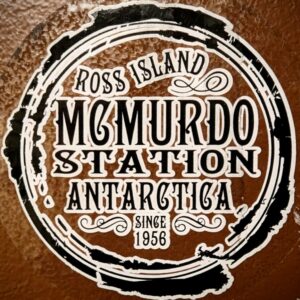In the early 20th century, Antarctica stood as one of the last unexplored frontiers. As nations prepared for the International Geophysical Year (IGY) in 1957-58, the United States chose Ross Island for its primary research station, McMurdo, thanks to decades of pioneering expeditions that unlocked the continent’s secrets.
Legendary Heroic Era Explorations
During the early 1900s, famed explorers like Robert Falcon Scott and Ernest Shackleton embarked on astonishing journeys across Antarctica’s interior from Ross Island and McMurdo Sound. Their expeditions proved this remote coastal area was an ideal jumping-off point for venturing into the ice-bound continent’s heart.
Robert Falcon Scott’s Expeditions
- Discovery Expedition (1901-1904):
- Scott led the British National Antarctic Expedition, commonly known as the Discovery Expedition.
- The team established a base at Hut Point on Ross Island.
- They made significant geographic and scientific discoveries, including the first ascent of the Antarctic plateau.
- This expedition paved the way for future explorations by demonstrating the feasibility of conducting scientific research in Antarctica.
- Terra Nova Expedition (1910-1913):
- Scott’s ill-fated attempt to be the first to reach the South Pole.
- The team established supply depots along the route from McMurdo Sound to the South Pole.
- Despite reaching the South Pole, Scott and his party perished on the return journey.
- This expedition highlighted the extreme challenges of Antarctic exploration and the importance of careful logistical planning.
Ernest Shackleton’s Expeditions
- Nimrod Expedition (1907-1909):
- Shackleton aimed to reach the South Pole and establish a route to it.
- The team reached a point just 97 nautical miles from the South Pole before turning back.
- They also discovered the Beardmore Glacier and reached the summit of Mount Erebus.
- This expedition set new records for the farthest south latitude and provided valuable scientific data.
- Imperial Trans-Antarctic Expedition (1914-1917):
- Shackleton’s ambitious goal was to make the first land crossing of Antarctica from the Weddell Sea to the Ross Sea.
- The Ross Sea Party, led by Aeneas Mackintosh, was responsible for laying supply depots from McMurdo Sound to the Beardmore Glacier to support Shackleton’s crossing.
- The team established a base at Cape Evans on Ross Island and faced severe hardships, including the loss of their ship, the Aurora.
- Despite limited supplies and extreme conditions, they successfully laid the depots, but three men (Mackintosh, Victor Hayward, and Arnold Spencer-Smith) perished in the process.
- The Ross Sea Party’s perseverance and sacrifice were crucial to the overall mission, even though Shackleton’s main party never completed the crossing.
These feats laid crucial groundwork for scientists determining ideal locations for semi-permanent Antarctic stations. Ross Island and McMurdo Sound offered perhaps the most practical access point for charting the continent’s vast unexplored interior and supporting personnel and supply deliveries.
Insights from Little America Camps
The U.S. program’s Antarctic efforts began with Richard E. Byrd’s 1928-30 expedition, which established rudimentary coastal camps along the Ross Ice Shelf and McMurdo Sound. These primitive encampments – dubbed “Little America” – yielded invaluable lessons on withstanding Antarctic living conditions.
Summary of Little America Camps:
- Little America I (1928-1930):
- Located on the Ross Ice Shelf, it housed over 40 men in basic shelters.
- The team endured over four months of total darkness, providing crucial knowledge on the physical and psychological tolls of isolation.
- Little America II (1933-1935):
- Expanded scientific activities, including meteorology and geology.
- Reinforced the importance of McMurdo Sound’s logistical advantages, such as relatively ice-free waters and better shelter construction.
- Little America III (1940-1941):
- Conducted primarily aerial surveys and mapping of the Antarctic interior.
- Further highlighted the strategic importance of Ross Island as a logistical hub.
- Little America IV (1946-1947):
- Part of Operation Highjump, the largest Antarctic expedition to date.
- Focused on extensive aerial photography and mapping.
- Little America V (1955-1956):
- Supported the International Geophysical Year (IGY) scientific activities.
- Provided valuable data on glaciology, seismology, and meteorology.
These camps provided invaluable insights into living and conducting research in Antarctica, further reinforcing McMurdo Sound’s strategic advantages.
Unrivaled Access to Antarctica’s Interior
While other coastal regions were considered, Ross Island’s well-established history as an Antarctic foothold gave it a clear strategic edge for supporting the overland expeditions and continental scientific aims planned by the U.S. program.
Advantages:
- Maritime Supply Corridor: The predominantly ice-free McMurdo Sound offered an optimal maritime supply corridor for seasonal deliveries of personnel, provisions, fuel, and heavy equipment required to sustain year-round habitation.
- Logistical Necessity: This accessibility was crucial for maintaining continuous research operations.
Coordinated Efforts with New Zealand
Selecting Ross Island also facilitated close cooperation with neighboring New Zealand, which was establishing its own research headquarters at Scott Base just miles from the future McMurdo Station site. This strategic co-location enabled both nations to share resources and assets while pursuing long-term Antarctic operations. Scott Base served as a New Zealand scientific hub, while McMurdo was the larger logistics nexus linked to each nation’s supply chains.
Embracing Antarctic Extremes
Of course, constructing permanent human habitats in one of Earth’s most extreme environments was considered an immense challenge in the 1950s. The severe weather, isolation effects, and other Antarctic realities meant uncertain outcomes for long-term survival.
However, the unprecedented scientific opportunities overshadowed the risks. The first-hand experience from previous coastal camps, coupled with Ross Island’s advantageous location and accessibility, positioned McMurdo as the optimal Antarctic foothold. Leading up to 1957, extensive preparations commenced to construct McMurdo Station – a landmark facility marking a new era of Antarctic exploration and research that endures over six decades later.


